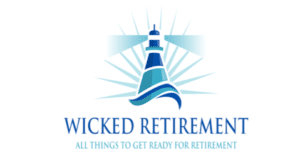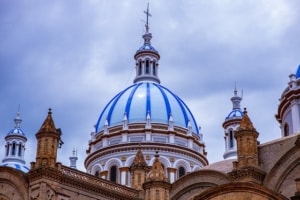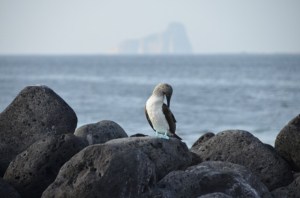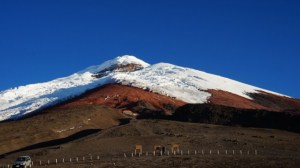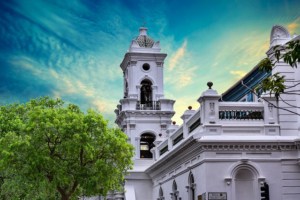This post may contain affiliate links, see our disclaimer page for more info.
Should I Retire To Ecuador?
If you’re doing your retirement planning and asking yourself “should I retire to Ecuador?” the short answer is, it most definitely needs to be on your list of considerations. Affordable, amazing culture and wicked weather Ecuador is a must visit.
Ecuador, officially known as the Republic of Ecuador located in the northwestern region of South America. It is bordered by Colombia on the north, Peru on the east and south, and the vast Pacific Ocean on the west. Its capital is Quito which is also the largest city in the country.
This ethnically diverse country houses a population of 16.4 million who are mostly mestizos (more about them further in the article). The diversity in the population can be attributed to the Spaniards colonizing them back in the 16th century and the Amerindian group who settled and was later incorporated into the Inca Empire in the 15th century.
This country offers a great ocean view, a choice of tropical, temperate, rainforest or humid subtropical climates, low cost of living and a thriving community of expats. All of these benefits plus the low medical cost in this country can be enjoyed with just a flight away from your home.
Should I Retire to Ecuador? Weather
This country is considered to be one of the 18 Megadiverse countries in the world. This means that it is a country that houses the majority of Earth’s diverse species and has a high rate of endemic species.
With a total area of 283,561 square kilometers where 276,841 square kilometers is land and 6,720 square kilometers is water plus 2,337 kilometers of coastline, this country’s weather and climate depend greatly on where you are located.
Thanks to the Andes Mountains of Ecuador, four major geographical regions are created which experience its own climate. We have La Costa or the coast, La Sierra or the highlands, La Amazonia, also known as El Oriente or the East, and La Region Insular.
La Costa (The Coast)
This part of the country is where most of the rice crops are grown. It is also where the banana plantation of the famous companies Dole and Chiquita is located. Incidentally, this is also the most fertile region of the country. Coastal provinces situated in this area have active fisheries.
The provinces west of the Andean range are part of this region with Guayaquil, officially known as Santiago de Guayaquil (the largest port of the country and also the second largest city), as the largest coastal province. This region experiences a humid subtropical climate with heavy rain season.
La Sierra (The Highlands)
The provinces in the Andean and Interandean range belong to this region. The largest highland city is Quito which is also the country’s capital and largest city. Volcanoes and snow-capped mountains litter this region. Farmers in this area focus on growing crops such as potatoes, corn (locally known as maize) and quinoa in the fertile valleys of the region.
These mountain valley provinces experience mild climate all year round. It can be described as temperate and moderately dry. Sunshine is often seen but the temperature is much cooler here.
La Amazonia (The Amazon) or El Oriente (The East)
This region houses the Amazon provinces where vast Amazon parks and sanctuaries for Amerindian tribes can be found. This is also where Ecuador’s large reserve of petroleum is located. In fact, a portion of the upper Amazon area is largely exploited for this commodity by petroleum companies. The largest province is Sucumbios where the largest city; Lago Agrio, in the Orient is found. Not far behind this city, in terms of size is Macas in the province of Morona Santiago.
As this is the Amazon, this region has a rainforest climate. However, since this region serves as the drainage basin of the Amazon river, it’s location and environment affects the climate greatly. The Amazon is actually a major river that runs through the rainforest and the forest surrounding the river is called Amazonia. Typically, the climate here is hot and humid which produces large quantities of condensation in the air that then turns into rain. Temperature is a constant 79℉ all throughout the year.
The Amazonia is considered to be the Earth’s lungs because it produces 20% of the world’s oxygen supply. Its forest is considered as the biggest ecosystem on earth and the majority of it is still unexplored.
La Region Insular (The Insular Region)
This mainly is comprised of the Galapagos Islands which is a cluster of volcanic islands located in the Pacific Ocean. Known to be home of the most number of endemic plants which are scattered all over the 18 main islands, 3 minor islands, and 107 rocks and islets of this archipelago.
The Galapagos Islands is located near the equator which would make you think that it is a tropical place, that is partly true. This group of Island houses mountains and volcanoes which means there are highlands and lowlands. Highlands typically are considered wet and lowlands, arid. The cold water brought in by the Humboldt Current also causes light but frequent rain to occur most of the year.
There are two seasons in this region, the wet season known as garua and the warm season. During the garua season which lasts June to November, cold air is carried by the wind from the south and southeast. A blanket of dense fog covers the islands and drizzles can last throughout the whole day. The warmer months of December to May is characterized with no winds, lots of sunshine and random rains that are much stronger than the ones felt during garua.
Should I Retire to Ecuador? Cost of Living
Similar to other countries that have gained popularity in the expat community, Ecuador gained attention because of the low cost of living compared to the US and Europe. Also, this nation has a rich Spanish colonial history that very much shows in the old buildings and tradition this country has.
Upon crunching the numbers, a total of about $20,400 expense per year or $1,700 per month for a couple living in the city of Cuenca came up. This includes rent, utility bill, once a week maid service, groceries (alcohol not included), car expenses (gas and maintenance), healthcare, leisure expense (dining out or movies) and other miscellaneous expense.
A single person, on the other hand, can live in this country for about $1,440 per month. That would total to a years expense of $17,280 and that includes all the expenses mentioned in the previous paragraph.
Retirees aging 65 years old and above have a special discount in this country too. They have a group of seniors aging 65 and above called “Tercera Edad” which literally translates to “Third Age”. It’s a fancy way of labeling the senior citizens of the country but this age group enjoys a lot of privileges and discounts.
Should I Retire to Ecuador? Internet and Infrastructure
This small nation with an abundance of resource has an extensive road system that connects the provinces and cities. To be exact, Ecuador has a total of 43,197 km of highway with 8,165 km paved that serves as part of the farm to the market road system that the locals use.
Internet
A total of eight internet service providers are available in this country. Keep in mind that this country’s major population cannot afford to own a television, computer or radio. So this means that the service is somewhat a little on the less than desirable performance side.
Both the telecommunication and electrical services are state-owned which is why it is available to Ecuadorians at subsidized rates. Do not be discouraged by this though, the communications trade is quickly growing. With proper management and funding, this sector will continue to improve in the coming years.
Of the eight internet service providers, the most popular are TV Cable, Corporacion National de Telecomunicaciones (CNT), PuntoNet, Claro and Movistar. Claro, Movistar, and CNT offer thumb drives that are perfect for back-up connections and travels because of its portability and pay as you go scheme.
CNT and PuntoNet charge $50 for installation. However, this fee can be waived if you opt for a phone package. TV Cable is the most popular in terms of speed but their customer service is rated very poorly by many. CNT does not cover as much range as TV Cable but they do offer great discounts for customers getting more than one package.
Expats who look for wifi availability should head to Quito and Guayaquil since these places offer a variety of places that have wifi most than other cities. It is best to remember that the country is going under major changes with regards to their infrastructure and that includes their telecommunication and internet services. This means that internet connection may not be always as fast as you are used to or in some cases not free.
Infrastructure
Commuters would be happy in this nation because buses and taxis within the city are available 24/7 with reasonable fare. In fact, many articles mentioned that it is not necessary for a tourist to bring a car with them. Rentals can be easily found and are much more economical.
The infrastructure system actually is undergoing major updates in the last 6 years. Thanks to the government, the outdated sewer system, potable water supply, electrical services and road system that has been neglected for more than 50 years have now been given the much-needed attention it needs. With a substantial budget allocated to the betterment of the country’s infrastructure, more upgrades can be expected in the coming years.
Should I Retire to Ecuador? Is it safe?
This country has seen many tourists enter their territory in the last couple of years since 1995. The number continued to grow until an estimated 1.5 million people visited the country last 2014. Most are tourists that want to explore the beautiful beaches of the nation while some are biologists, scientists, and other experts who are more interested in the environment and the Amazon.
Safety in Ecuador is a matter of being smart and alert just like in any other foreign country you visit. The US Department Of State labeled Ecuador as a place where “extreme caution needs to be exercised at all times due to crimes.” Places that are on the border of Colombia has a “do not travel” label due to some FARC activities recorded.
The 20 km stretch of “no-go” area bordering Colombia in the north has the northern province of Esmeraldas and other neighboring provinces experience bombings, kidnappings, and even missing journalists who are then later found to be murdered. This is the main areas where safety for tourists and other travelers are very low.
Most crimes committed to tourists are pickpocketing, theft, and robbery which usually is the case on other tourist destination countries. Staying alert and smart is always great advice to follow wherever you may be.
Since safety doesn’t just translate to crimes, it is also worth mentioning that Ecuador is a country littered with volcanoes. Traveling here also means that you are subjecting yourself into the minuscule possibility of experiencing and witnessing a volcanic eruption. Earthquake is also a consistent threat in this country with tsunamis on the coastal areas.
It is extremely recommended that you prepare for these eventualities. Make sure that you are properly informed of what is happening in the place so that you can plan for additional insurance if needed. Stay informed of current events regarding your travel to make sure that you have a window of opportunity to put on the breaks and head back to safety if ever things go sideways.
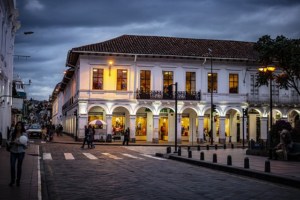
Should I Retire to Ecuador? Homes and Real Estate
Most real estate agents will tell you that the condition of the real estate sector in Ecuador is currently bad. For people who are selling properties and developers who have housing projects here, it is quite true. The effect of oil prices on the real estate market made it hard for agents to increase the price of the properties available in the market.
Sellers are now decreasing their offers by as much as 30% of the original asking price to more possible buyers for their property. This translates to “perfect time to buy properties due to low prices” for expats. Those who are viewing this country as their retirement destination would benefit from this recession in real estate. They have to act fast though because prices are already starting rise since the beginning of 2019.
Now there are those who prefer a more relaxed approached than buying property straight away. These type of people prefer to rent for a while to get a feel of the Ecuadorian lifestyle.
Should I Retire to Ecuador? Should I rent or should I buy?
Renting offers you many advantages especially if you are new to the area. You are able to scout your current location and determine if everything is up to your standard. Most renters are in Ecuador during the winter months in their hometown, they would leave when the climate back home is warm enough.
These type of renters are what you can call “wandering renters” because most of them would rent in a new location each year. It is actually a good practice to try if you are looking at Ecuador as your retirement haven. You have the ability to tour the different cities of the country and decide which one is the most appropriate for you when your retirement comes.
Buying a property in Ecuador is another story. Many say that it is easy especially if you employ the help of local attorneys and notary public officers. It was even mentioned that a purchase would take a short one month processing period from start to finish. Attorney fees can range around $250 USD give or take and notary public officer around $350 USD. They will help you out determine other fees needed once you’ve located the property you want to purchase.
Should I Retire to Ecuador? Visa Process
Visitors of this nation who are holding the USA, Canada, Australia, and UK passports can stay anywhere from 30 to 90 days under a T-3 tourist visa. This tourist visa will be stamped on your passport. Your passport should be valid for at least six months in order to gain a tourist visa in this country.
You can extend your visit for another 90 days by applying for an extension at an Immigration Office near you. You must do this personally or if you prefer, you can exit the country then re-enter. This will set you back $230 USD plus $50 USD consular fee if you are applying personally at an Immigration Office.
It is important that you do not stay longer than what your tourist visa allows you. Overstaying can result in deportment and a re-entry ban will be issued to you for one whole year. Once caught by the authorities, you will then be charged with fines that can reach up to $2,000 USD and also be forced to leave.
If you are staying more than the 180 days tourist visa, it is recommended that you apply for a six months tourist visa before you visit Ecuador. This six months visa is now known as the “Commercial Act Visa” that costs $230 USD. Additional charges for this visa are the application fee ($30 USD) and proof of income letter written in Spanish ($40 USD). This proof of income letter is written is a document that is written to verify that you are financially qualified to stay in the country for six months.
For expats wanting to really spend the rest of their golden years in this nation. A residency visa would be your option. One way of gaining this visa is to purchase a property in the country that is worth $25,000 USD or more. This purchase gains you a title of an investor in the country and also automatically grants you an Investor of Real Estate or Securities Residency Visa.
Another way is to get the Pensioner Visa. This is specifically intended for retired people who are living off of their pension income. Income must be at least $800 USD per month to qualify for this visa. Other resident visa options are the following:
- Industrial Investor Visa for investors who plan to export products of Ecuador with a capital of at least $30,000 USD.
- Legal Representative, Work Visa, or Religious Visa issued to company representative holding unlimited power of attorney, technical experts or technicians without a definite work contract with a company in Ecuador and to members of religious organizations.
- Professional Visa for people who are university degree holders and are considered professionals who wish to practice their profession in the country.
- Economic Dependence Visa is given to individuals who are financially and economically dependent on a relative or spouse who is a holder of an approved immigration visa of the country.
All applicants of any residency visa offered by the Ecuadorian state are required to submit the following documents:
- A letter of visa petition addressed to the current Director General of Extrajeria. This document must be duly signed by an attorney and the applicant.
- The completed appropriate visa-type form called “Solicitud de vis de inmigrante.”
- Copy of up-to-date passport (should be valid for at least six months) duly notarized with a statement that verifies that the document is legal and current.
- Original copy of the completed “hoja de datos para la cedula” form. This is a data sheet used to gather the information that will show in your identity card.
- 2 copies of recent passport sized colored photo with white background.
- Application fee of $350
Retirees applying for pensioner visa will need to pass these additional documents:
- Copies of retirement documents stating the pension amount received with a proper certification coming from the authorized party and with authentication from Ecuadorian Consul in the country of origin.
- A certificate from the Ecuadorian Consul in your hometown stating that the income fund is no less than $800 USD per month for the main applicant and an additional $100 for each dependent.
Should I Retire to Ecuador? Healthcare
As an expat, you will need to consider the place where you will get the most healthcare accessible to you. This is more important for expats who are suffering from illnesses that may need immediate medical attention when triggered. Pensioners who are in their golden ages also prefer to be close to medical facilities which is why it is best that you look for the cities and provinces that can provide you with the proper healthcare you may need.
Cuenca, Quito, and Guayaquil are the places that house a variety of clinics and different medical facilities. Consider them as your retirement destination if public healthcare is on the top of your priority. If you feel that public healthcare is something that you don’t want to deal with, you can choose a private one.
Private healthcare is available for expat in this country. This will, of course, cost much more than sticking to public healthcare. However, the cost is still very much affordable in terms of US and Europe standards. You have a top notch treatment without the wait and long lines to deal with.
Many private clinics in Ecuador are equipped with state of the art machines and hires highly trained and skilled specialists as part of their team. You’ll realize that plenty of Ecuadorian doctors are trained in Europe, Canda and the US. It is no wonder why these doctors will have no problem communicating with you.
A law in 2016 was passed that required all foreign tourists and residents to get Ecuadorian health insurance. In fact, it has become one of the requirements in applying for a visa in this country. Still, having a more comprehensive back insurance plan is recommended to address any severe illness or long-term medication illness.
Not to bring the public healthcare down, it too is experiencing radical changes and improvements since 2008. Thanks to president Correa who spearheaded the improvements of the country including the public healthcare system. Now, if you want some minor treatment for a simple illness, you can go into public clinics that are scattered all over Ecuador for treatment. For a more major illness, you only need to walk-in a free public hospital to get treated.
But because a public hospital is free, luxury is not something these hospitals possess. They do, however, have state-of-the-art equipment found in private hospitals too. Most expats decide to get private healthcare because it offers luxury, high-end facilities and top-notch treatment all in one for a fraction of a cost compared back home.
Should I Retire to Ecuador? People, Culture and Entertainment
Ecuador is a country that contains plenty of natural resources with diverse ethnic groups scattered throughout the land. The Spaniard colonization of this country brought it many traditions and cultures that are being practiced up to this day.
People
With a population of 16.62 million back in 2017, the largest ethnic group in Ecuador this time is the Meztizos. They are descendant of the Spanish colonizers back in the days that intermingled and married the locals of the country. Today, the white population of Ecuador is a mixture of local’s interbreeding with European immigrants who have put roots in the country in the 20th century.
The main religion in this country is Roman Catholicism. It is estimated that 80.44% of the population are Roman Catholics, 11.30% are Evangelical Protestants, 7.94% are atheists 6.97% comprise other religions (Jewish, Buddhist and Latter-day Saints), 1.29% are Jehova’s Witness and 0.11% are agnostics.
There are places that have combined the Catholic beliefs with the Amerindian beliefs creating parades that are based in the Catholic Religion but is incorporated with some rites and icons of the Amerindian belief.
Culture
Majority of the culture in Ecuador comes from the Hispanic mestizo ancestry. This concentrates more on Spanish heritage with some Amerindian traditions mixed into it. Spain’s success in colonizing this country led to the adaptation of their culture in the land. This is also the main reason why most Ecuadorians speak Spanish. Amerindian language such as Kichwa is also spoken by the population.
In this country, a “national genre of music” is honored by many. This music is of indigenous Latin origin and is called Pasillo. Other influences have joined through the years creating many forms and types of music such as albazo, pasacalle, tonada, and many others.
Part of the culture in Ecuador is their food which like the language and religion in this country is greatly influenced by the outside nations. It can also be considered diverse due to the differences in altitude which greatly influences the availability of crops and other agricultural produce.
Most Ecuadorians follow a three-course meal pattern where soup is served in the beginning, followed by the second course of rice or any protein source and the last is a dessert with coffee to finish the meal. Dinner usually is a light meal of bread and coffee or tea.
As mentioned before, the food varies from region to region. Highland menu consists of chicken, pork, beef and cuy (guinea pig) served with rice, corn or potatoes. While in the coastal region, seafood is the star in each meal. This is where you will taste one of the freshest ceviches in the world served with fried plantain, popcorn or tostado.
Another popular menu in the coastal region is the Churrasco. It is a Spanish/Portuguese term referring to grilled meat (especially beef) seasoned with chimichurri, served with plantain, white rice or french fries, fried egg and slices of avocado. Dishes with coconut sauces are also popular and is called Encocados.
Amazon region has a different dietary staple. A root crop called yuca or more known as cassava is a major part of their diet here. It is one of the main sources of carbohydrates in this region together with rice and corn.
Entertainment
Just like in any South American country, Ecuadorians love sports. Football is the national sport of the country and this is the number one leisure past time of Ecuadorians. Other sports are also enjoyed by the population such as tennis, basketball, and volleyball. You’ll also find bullfighting in this country and there are professionals that put on a show during festivals in Quito for you to enjoy.
You can enjoy water sports such as surfing, sea kayaking, diving and snorkeling when you visit the coastal areas of the country. A word of caution to would be visitors of this coastal country, make sure that you don’t do any activity that may cause damage or threaten the environment of the region.
You can witness the Guayaquil marathon if you are in the area during the first Sunday of October. A number of golf courses can be enjoyed in Ecuador with beautiful sceneries and wonderful facilities that your family will enjoy. Go for the 18 hole courses if you are up for it or maybe just a 9 hole course is what you want fora shorter game.
Major towns and cities of the country also have shopping facilities and malls than you can tour with your kids and partner.
Attractions
Ecuador is a country teeming with life and character. Enjoy the lush nature in Galapagos Island, Yasuni National Park, El Cajas National Park, Sangay National Park, Podocarpus National Park, Vilcabamba, and Baňos de Agua Santa.
Immerse yourself the cultural attractions offered by the Historic Center of Quito, Ciudad Mitad del Mundo, Ingapirca, Historic Center of Cuenca Latacunga and the Mama Negra Festival.
Hike the snowy volcanoes of Antisana, Cayambe, Chimborazo, Cotopaxi, and Illinizas for a thrilling adventure.
Soak up the sun in the beaches of Crucita, Atacames, Bahia de Caraquez, Esmeraldas, Manta, Salinas, and Montanita.
Should I Retire to Ecuador? Overall
As an expat in Ecuador, you have the chance to stretch your retirement funds further because of the low cost of living in this country. You have the chance to choose the region (with different climate) where you want to spend your time, enjoy the developing economy and watch infrastructure and telecommunication services get better through the years.
As long as you stay out of the “no-go” areas, you will only have to contend with pickpockets and frauds if you are living in the major cities. Healthcare is continuously improving too but a backup plan is always a plus. With proper planning and preparation, you will get to enjoy this country’s natural wealth, beautiful historical culture, and perfectly maintained beaches.
So should I retire to Ecuador, in short, it should be on your list.
As always, if you like this post or the blog please share it.
My goal is to create a retirement community where everyone can share their experiences of either being retired (we want to learn from you), preparing to save for retirement or making more money for retirement we want to hear from you.
If you are at all interested in creating your own blog (I have so much fun with it!) I highly recommend Alex and Lauren’s courses at Create and Go. They have tried it all and now offer these courses on how to set up your own blog and avoid the mistakes they made.
They explain everything in a way that is easy for anyone no matter what age you are to create your own blog.
You can make money Blogging, by the way, Alex and Lauren made $150K last month, so they know what they are talking about. It is an affiliate link, but I have purchased all their courses and love them and there is no extra cost for you. They are by far the experts in this area and genuinely want you to be successful.
My review of their Launch your Blog Biz is here.
My review of their Pinterest Avalanche Course is here.
All the resources I recommend can be found on the Resources Page. I wouldn’t recommend them if I didn’t use them myself.
If you have any questions don’t hesitate to drop me a line at theteam@wickedretirement.com I’ll always respond.
